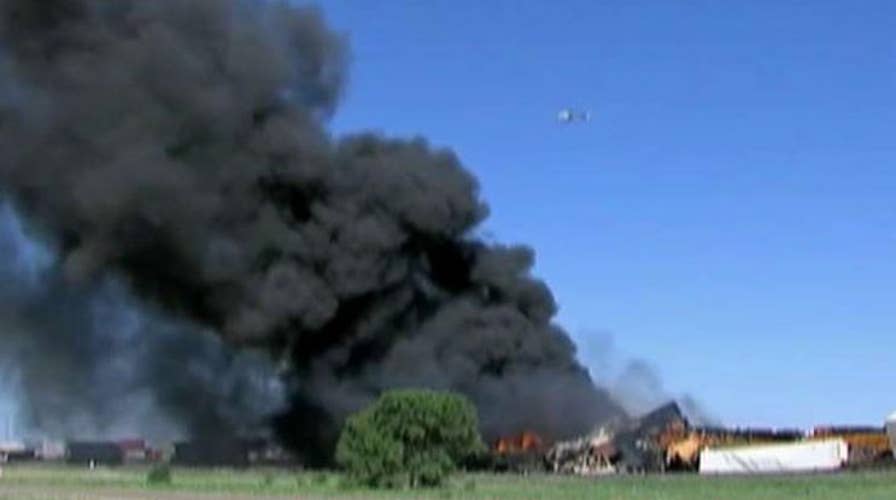Two trains collide head-on in fiery crash
Three train crew members missing, believed trapped under the rubble
The remains of two train workers killed in a head-on freight train collision in Texas were found Wednesday, officials said, while a third worker is unaccounted for and presumed dead.
The bodies were found in the wreckage of the two trains near the town of Panhandle, BNSF Railway spokesman Joe Faust said. A fourth crew member jumped from one of the trains just before impact Tuesday; he is hospitalized with injuries that are not life-threatening, Faust said.
Work crews continued to pick through the tangled and smoldering wreckage of the smashed locomotives, rail cars and shipping containers near the town of Panhandle, about 40 miles northwest of Amarillo, he said.
The BNSF Railway freight trains were on the same track when they collided, triggering a fireball and causing containers and cars to tumble onto one another in a pileup.
One train had earlier stopped in Amarillo to refuel for its trip to Chicago, and that diesel fuel contributed to a fire that burned into the night, Texas Department of Public Safety Sgt. Dan Buesing said.
"You have two engines on each train with fuel and the eastbound train had stopped in the Amarillo yard and may have had extra fuel added for the trip out east," he said. The westbound train was headed to Los Angeles.
Freight cars and containers were derailed and strewn about 400 yards from the collision site just outside the town of Panhandle, Buesing said. Floodlights were brought in overnight to aid emergency workers trying to quell the flames and start the search for the three crew members, he said.
Both trains carried stacked containers of consumer goods, such as paper products, clothing, television sets and computers.
It's not clear how fast the trains were traveling when they collided, but the speed limit in that area is 70 mph and BNSF spokesman Joe Faust said they were "traveling at less than track speed." It also wasn't clear why the trains were on the same track.
National Transportation Safety Board spokesman Keith Holloway said the NTSB has opened an investigation, and the Federal Railroad Administration said it has investigators on site.
BNSF has pledged to meet a 2018 federal deadline to adopt technology, called positive train control or PTC, that relies on GPS, wireless radio and computers to monitor train positions and automatically slow or stop trains that are in danger of colliding, derailing due to excessive speed or about to enter track where crews are working or that is otherwise off limits. At least three freight railroads have said they'll need an extension to 2020.
Faust said the collision is the type of accident PTC can prevent and that BNSF is "aggressively" pursuing it "across our network."
"While sections of the track operated by the eastbound train involved in this accident have PTC installed and are being tested, the section of track where the incident occurred will be installed later this year," he said in a statement released Tuesday.
It's not unusual to have an accident in the Panhandle involving a truck that's struck by a freight train, Buesing said, but the magnitude of Tuesday's accident was startling.
Tuesday's accident is at least the second in recent years involving BNSF trains striking one another. In September 2013, three were involved in a wreck near Amarillo that injured five crew members, according to an NTSB report. The federal agency in that incident faulted the crew in one train for improperly proceeding past a signal and striking the rear of a stationary train, and cars that derailed were then struck by a train passing in the opposite direction.
The Associated Press contributed to this report.






















